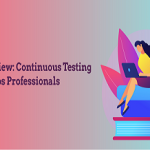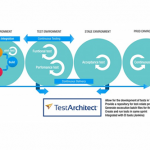Sauce Lab’s Perspective on Integration with Continuous Testing

The term ‘DevOps’ implies that implementing an effective development and production workflow is as easy as developing the collaborative interaction between developers and IT operations. On the surface, DevOps may appear as a simple and straightforward idea but, as you will find out, there is more than meets the eye.
Yet adopting DevOps effectively is more complex than combining Dev and Ops. Quality Assurance Engineers who oversee software tests are an equally crucial component to successfully implementing DevOps. In addition, organizations that attempt to implement DevOps without building Continuous Testing into their delivery pipelines will fall short of achieving the full benefits of DevOps.
Continuous Testing is the key to successful integration of quality assurance into DevOps workflows. It is the only way to ensure that quality assurance is as continuous, Agile, and reliable as the rest of the DevOps operation. Considering this point, Continuous Testing serves as the glue that binds together all of the processes that comprise the Continuous Delivery pipeline. Without automated and Continuous Testing, DevOps is inefficient.
The Benefits of DevOps
To understand why automated testing is critical for effective DevOps, it is necessary to identify the benefits that organizations seek to achieve by following DevOps principles. The primary benefits of a well-designed and maintained DevOps environment include the following:
- Seamless communication across all parts of the organization. DevOps does this by eliminating the silos that have traditionally separated different teams from one another.
- Rapid, continuous, and reliable software changes delivered on a continuous basis. This requires software updates to be broken into small parts that can be designed, written, tested, and released into production continuously.
- Maximize agility. When software delivery is agile, applications in your tool chain can easily scale in response to fluctuations that are in demand. In addition, software delivery teams have the ability to switch easily between development frameworks and tools according to shifting needs or preferences.
- The elimination of unforeseen delays in software production. These delays typically result from having to fix problems with the code after it is in production, at this point rollbacks are costly and time-consuming. Continuous Testing can help us avoid this risk by ensuring that code is tested automatically, as a component of the delivery pipeline, before it goes into production.

Why DevOps Needs Continuous Testing
The term DevOps entails collaboration between development teams and IT operations teams can optimize software delivery. However, this is not completely true. Software testers also need to be seamlessly integrated into the Continuous Delivery chain to work alongside development and IT Ops teams.
To be precise, integrating development with IT Ops is one important aspect of achieving DevOps. Software is delivered faster and more reliably when programmers are in constant correspondence with the system admins, who deploy and manage the software in production. Furthermore, speed and reliability increase when both of these groups enjoy maximum visibility into the state of application development.
Yet, this type of collaboration is not enough on its own to make DevOps work well. If software testers remain in a silo and do not participate in the Continuous Delivery chain, a number of problems arise. These problems include:
- The inability to test software updates at the pace at which they are produced and deployed. If automated software testing is not part of the Continuous Delivery pipeline, changes made by developers to the code cannot be tested continuously. They will instead have to be tested irregularly; whenever the testing team is able to address them.
- Agility is undercut. Even if the rest of the software delivery chain is Agile, failure to integrate automated testing into the Continuous Delivery pipeline will undercut the organization’s ability to derive value from that agility.
- Inadmissible quality. Part of the value of DevOps is its ability to standardize and streamline the software delivery processes. When automated testing is not part of the Continuous Delivery pipeline, tests remain irregular and ad hoc.
- Continuity rollbacks. To make the most of DevOps, testing should be automated and continuous.
- The introduction of bugs that force developers to roll back code once it has been written is a serious hamper to continuity.
Organizations that leave software testing in a silo rather than integrating it into the Continuous Delivery pipeline fail to achieve the objective of DevOps, even if the rest of their DevOps schema is well designed.

Continuous Testing: The Glue between Dev and Ops
Continuous Testing is crucial for DevOps because tests are the tie that binds development to IT Ops, and ensures that updates flow smoothly from the beginning to the end of the Continuous Delivery pipeline.
A typical DevOps delivery chain starts with developers, who design application changes and then write the code to implement them then, increasingly, go on to design the corresponding tests. The delivery chain ends with IT Ops, which is responsible for pushing the updates into production and maintaining them.
Software tests should be executed at every step along the way. Integration tests ensure that changes or new features written by developers can be added to the application without breaking it. End-to-end tests identify flaws that developers might not have foreseen when designing code. They also prevent those problems from reaching end users. Device compatibility tests ensure that code written and built in development environments will function as intended in real-world settings, which are much more complex, involving many more hardware and software variables than development environments.
A Continuous Delivery pipeline that lacks automated and Continuous Testing will not enable developers and IT Ops teams to interact effectively with one another.

How to Enable Continuous Testing
In order to integrate software testing effectively into a Continuous Delivery pipeline, DevOps teams should implement testing solutions that enable and reinforce DevOps goals. When choosing a testing platform, look for the following essential features:
The ability to test quickly. In order to avoid delays to your Continuous Delivery chain, you need to be able to perform tests quickly. Performing parallel tests on a large scale is one way to achieve this. Another option is, to first, run compatibility tests on simulated devices first (since these tests take less time) and then performing the more time-consuming tests on real devices later in the pipeline, prior to the code entering production.
The ability to scale. Your testing platform should be able to perform tests as quickly as needed and it should support as many parallel tests as you require. On-premises testing solutions are unlikely to offer the necessary scalability because they will be constrained by limited hardware resources. In contrast, a cloud-based testing platform can scale as seamlessly as the rest of your Continuous Delivery pipeline.
High automation. DevOps teams achieve their speed and agility in part by automating as much of the software delivery process as possible. Your testing solution should be as automated as the rest of your DevOps toolset. You should be able to trigger tests, analyze results, and share testing information across the organization in a completely automated fashion.
On-demand testing. To avoid kinks in the Continuous Delivery pipeline, you need to be able to perform tests whenever they are necessary. There are two ways to do this. One way is to maintain a massive on-premises testing environment with enough resources to perform tests whenever you need them, as well as maintain the test infrastructure. The solution is a cloud-based testing platform that can complete tests quickly upon request. A cloud-based platform is much more cost-efficient because it obviates the need to implement and manage an expensive on-premises test grid that is underutilized most of the time.
A Continuous Testing solution that includes the qualities that enable your developers and IT Ops teams to work together in the most efficient manner. This ensures that the code you put into production is reliable and stable across diverse environments. It also empowers your organization to derive full value from its migration to a DevOps-based workflow by maximizing the agility, visibility, scalability, and continuity of your software delivery pipeline.


















